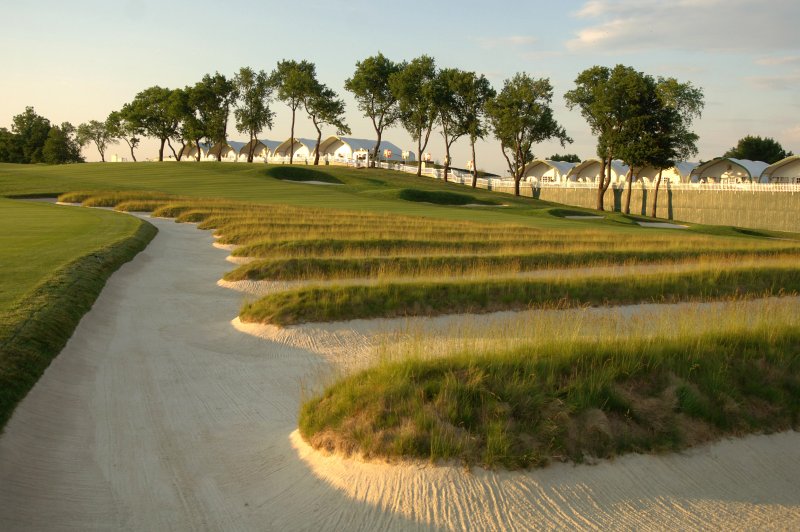1 of 7 | The sun sets on famous Oakmont "Church Pews" bunkers between the third and fourth fairways, at the Oakmont Country Club in Pennsylvania. Oakmont is hosting the U.S. Open for a record ninth time. Photo by Kevin Dietsch/UPI |
License Photo
When you think of great golf in the US, the areas that come to mind are California, Florida and Texas.
California for its gorgeous coastlines and courses like Pebble Beach, Florida for its weather and the winter part of the PGA tour, Texas as the home of Ben Hogan and Byron Nelson, among others.
Anyone who ever has been there would quickly add Hawaii to that geographical list.
No one thinks of Pennsylvania as a golf Mecca.
Yet when the US Open is played at Oakmont Country Club near Pittsburgh this week, it will mark the resumption of an old trend: More USGA championships have been contested in the Keystone State than in any other.
Yep, more than California, more than Texas or Florida or New York or anywhere else.
In fact, the Open will be the 84th USGA championship contested in Pennsylvania - equalling the total of USGA championships held in such renowned golf meccas as Texas (29), Virginia (20), Florida (20) and Arizona (15) combined. More than California's 75 or New York's 69 or Massachusetts' 55.
This will be the ninth Open contested at Oakmont. That is more than any other golf course in the country. In fact, this year will be almost a celebration of Pennsylvania golf by the USGA with the US Women'a Amateur in August, the US Mid-Amateur and the US Women's Mid-Amateur, both in September, also played in Pennsylvania.
Now, Pennsylvania is not Augusta or St. Andrews or Pebble Beach. From an outside perspective, it might seem to lack that charm or quirkiness. It surely lacks the ocean. But what it does not lack is history.
It's not just that Pennsylvania has hosted a lot of championships. It's what has happened there that golf historians remember.
Bobby Jones finished his grand slam at Merion outside Philadelphia in 1930.
Jack Nicklaus, only 22 at the time, won his first major championship, the US Open in 1962 at Oakmont.
Lee Trevino pulled the fake snake out of his bag before a US Open playoff, which Trevino won, against Nicklaus in 1971 at Merion.
A golfer of some repute, Arnold Palmer, grew up in Latrobe, about 40 miles from Pittsburgh.
Ben Hogan, thought unlikely ever to walk again, not only walked but returned to championship form winning the US Open at Merion in 1950, just 16 months after his near-fatal car crash.
Johnny Miller staged one of the all-time great comebacks, shooting a final-round 63, a score which since has been tied but never bettered in a major championship, to come from six strokes behind, pass a dozen players, and win the US Open in 1973 at Oakmont. Some still consider this the greatest round ever played; Miller hit all 18 greens in regulation.
Disappointments occurred in Pennsylvania, too, none more severely than what happened to Sam Snea in the 1939 Open at Philadelphia Country Club. Snead made a triple bogey on the 72nd hole when a double bogey would have put him into a playoff and even a bogey would have allowed him to win the championship, the only major that he never won. Jean van de Velde, the Frenchman who threw away the 1999 British Open by making triple bogey on the 72nd hole at Carnoustie, had nothing on Snead.
And those are just the highlights.
Seniors and women get into the act in Pennsylvania, too. Hale Irwin set a scoring record for the Senior Open at Saucon Valley near Bethlehem. In the 2002 Curtis Cup, Carole Semple Thompson, daughter of a former USGA president, overcame a three-hole deficit to win the cup clinching match at Fox Chapel, near Pittsburgh.
Some of the young stars on the current PGA tour also won significant victories in Pennsylvania - Rickie Fowler in the 2009 Walker Cup at Merion, Hunter Mahan coming from three holes down to defeat Camilo Villegas in the 1999 US Junior Amateur at the Country Club of York.
There is no easy explanation for why golf has been so good and so strong in Pennsylvania, but we can try one.
The eastern part of the state, around Philadelphia, has much of the metropolitan appeal of, say, New York and northern New Jersey, which is to say a lot of people with a lot of money so they demand good facilities for golf. And the western part of the state shares with eastern Ohio what is really one of golf's great geographic features in the country, great, rolling hills that make for wonderful landscapes and inviting terrain for the game.
It's hard to beat, of course, California's coastline or the population of New York where, in the last couple of decades, the USGA has "discovered" iconic courses such as Shinnecock Hills and the public Bethpage Park on Long Island. But there are few areas that can match Pennsylvania both for the number of great courses and the history that has unfolded there.
And look for more starting Thursday.
--Ira Miller is an award-winning sportswriter who spent three decades with the San Francisco Chronicle, primarily writing about the National Football League but also extensively about golf.















